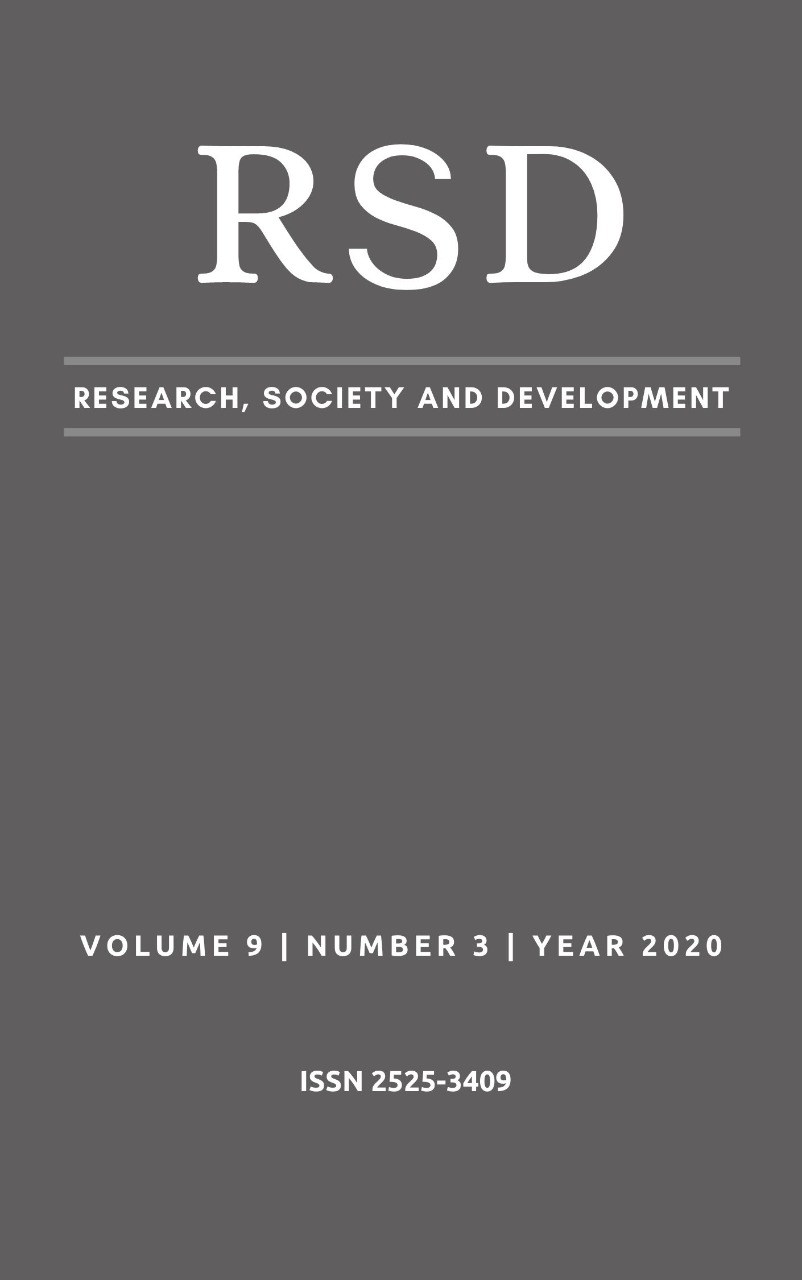Evolução da técnica odontológica do tratamento restaurador atraumático
DOI:
https://doi.org/10.33448/rsd-v9i3.2439Palavras-chave:
Odontologia, Tratamento Dentário Restaurador sem Trauma, Cárie Dentária.Resumo
O Tratamento Restaurador Atraumático (ART) foi originado com o intuito de sanar a necessidade de tratamento odontológico para comunidades carentes. Com o desenvolvimento da técnica ocorreu uma expansão do seu uso tanto na saúde pública quanto em consultórios particulares. Através de uma revisão da literatura, o presente estudo tem como objetivo integrar informações a respeito da história, evolução, vantagens e desvantagens da técnica, além de aprofundar o conhecimento dos cirurgiões-dentistas para que a realizem com mais confiança. Como o ART tem como fundamento a filosofia da mínima intervenção, seu uso é plausível em diversas situações, tanto em serviços públicos quanto privados, visto que a técnica preserva os tecidos sadios e reduz procedimentos mais invasivos como endodontias e exodontias. Existe a necessidade de que os profissionais aprofundem seu conhecimento em relação a técnica.
Referências
Dutra K.D.E.S, Amaral L.D, Vieira L.D.S. Tratamento Restaurador Atraumático (TRA) e sua aplicabilidade em comunidades menos assistidas. R Odontol Planal Cent, 2015, 5 (2), 23-8.
Figueiredo C.H. de, Lima F.A. & Moura K.S. DE. Tratamento Restaurador Atraumático: Avaliação de sua viabilidade como estratégia de controle da cárie dentária na saúde pública. RBPS, 2004, 17 (3), 109-118.
Franca C. da, Góes M.P.S. de, Domingues M.C & Colares V. A utilização do tratamento restaurador atraumático por odontopediatras. Arquivos em Odontologia, 2008, 44 (01).
Frencken J.E., Leal S.C. & Navarro M.F. Twenty-five-year atraumatic restorative treatment (ART) approach: a comprehensive overview. Clin Oral Invest, 2012, 16(5), 1337-1346.
Garbin C.A.S, Sundfeld R.H., Santos K.T. dos & Cardoso J.D. Aspectos atuais do tratamento restaurador atraumático. RFO, 2008, 13 (1), 25-29.
Guiotoku S.K., Nascimento M.I. & Pardim D.P. Tratamento Restaurador Atraumático (ART) como uma estratégia de promoção de saúde bucal na atenção básica. Rev. APS, 2013, 16 (3), 294-300.
Kuhnen M., Buratto G., Silva M.P. Uso do tratamento restaurador atraumático na estratégia Saúde da Família. Rev Odontol UNESP, 2013, 42 (4), 291-297.
Massara M. de L. de A., Wambier D., Imparato J.C.P. Tratamento Restaurador Atraumático (ART). Manual ABO - Odontopediatria, 2009.
Massara M. de L de A, Imparato J.C.P., Wambier D.S., Noronha J.C., Raggio D.P., Bonecker M. Tratamento Restaurador Atraumático Modificado (ARTm). Pesq Bras Odontoped Clin Integr, 2012, 12 (3), 303-06.
Monnerat A.F., Souza M.I. de C de, Monnerat A.B.L. Tratamento Restaurador Atraumático. Uma técnica que podemos confiar? Rev. bras. odontol., 2013, 70 (1), 33-6.
Monnerat A.F. TRA: Tratamento Restaurador Atraumático: Abordagens Clínicas em Saúde Pública. Rio de Janeiro: Elsevier, 2015.
Navarro M.F. de L, Leal S.C., Molina G.F. & Villena R.S. Tratamento Restaurador Atraumático: atualidades e perspectivas. Rev Assoc Paul Cir Dent, 2015, 69 (3), 289-301.
Pitts N.B.; Zero D.T.; Marsh P.D.; Ekstrand K.; Weintraub J.A. & Gomez F.R.; et al. Dental Caries. Nature Reviews Disease Primers, 2017; 25(3), 17030.
Silva M.A.M. da & Mendes C de A.J. O Tratamento Restaurador Atraumático em Saúde Pública e o custo dos materiais preconizados. Rev. APS, 2009, 12 (3), 350-356.
Silva H.P.G.P da, Azevedo T.D.P.L & Gomide M.B.B. A utilização do Tratamento restaurador Atraumático Modificado na Clínica de Odontopediatria. Odontol Bras Central, 2017, 26 (79), 67-72.
Silvestre J.A.C., Martins P. & Silva J.R.V. O Tratamento Restaurador Atraumático da cárie dental como estratégia de prevenção e promoção da saúde bucal na Estratégia Saúde da Família. APS, 2009, 12 (3), 350-356.
Tedesco T.K., Calvo A.F., Lenzi T.L., Hesse D., Guglielmi C.A.B. & Camargo L.B. ART is an alternative for restoring occlusoproximal cavities in primary teeth – evidence from na updated systematic review and meta‐analysis. Int J Paediatr Dent, 2017, maio (3), 201-209.
Tumenas I, Pascotto R, Saade J.L & Bassani M. Odontologia Minimamente Invasiva. Rev Assoc Paul Cir Dent, 2014, 68(4), 283-295.
Downloads
Publicado
Edição
Seção
Licença
Autores que publicam nesta revista concordam com os seguintes termos:
1) Autores mantém os direitos autorais e concedem à revista o direito de primeira publicação, com o trabalho simultaneamente licenciado sob a Licença Creative Commons Attribution que permite o compartilhamento do trabalho com reconhecimento da autoria e publicação inicial nesta revista.
2) Autores têm autorização para assumir contratos adicionais separadamente, para distribuição não-exclusiva da versão do trabalho publicada nesta revista (ex.: publicar em repositório institucional ou como capítulo de livro), com reconhecimento de autoria e publicação inicial nesta revista.
3) Autores têm permissão e são estimulados a publicar e distribuir seu trabalho online (ex.: em repositórios institucionais ou na sua página pessoal) a qualquer ponto antes ou durante o processo editorial, já que isso pode gerar alterações produtivas, bem como aumentar o impacto e a citação do trabalho publicado.


